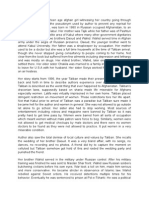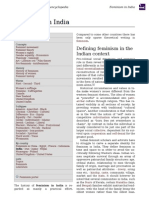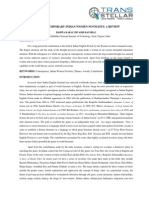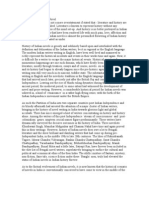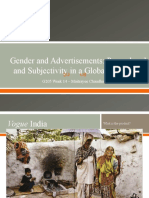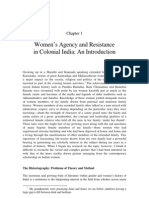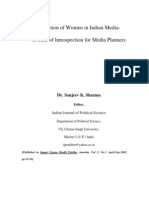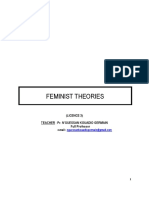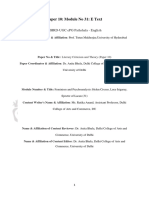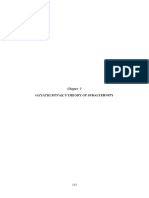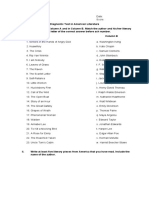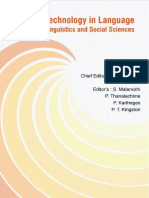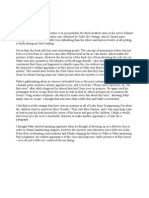Feminisim in The Indian Context
Feminisim in The Indian Context
Uploaded by
Manas NayakCopyright:
Available Formats
Feminisim in The Indian Context
Feminisim in The Indian Context
Uploaded by
Manas NayakOriginal Title
Copyright
Available Formats
Share this document
Did you find this document useful?
Is this content inappropriate?
Copyright:
Available Formats
Feminisim in The Indian Context
Feminisim in The Indian Context
Uploaded by
Manas NayakCopyright:
Available Formats
1
FEMINISM IN THE INDIAN CONTEXT: AN INTRODUCTION
This chapter presents an overall view, about feminism movement in general and specifically rises of feministic writings in Indian English Literature. The writers considered here from pre and post- independence era of the country.
1.1.
Concept of Feminism
The word Feminism seems to refer to an intense awareness of identity
as a
woman and interest in feminine problems. The subjugation of woman is a central fact of history and it is the main cause of all psychological disorders in society. According to Janet Richards, The essence ofFeminism has a strong fundamental case intended to mean only that there are excellent reasons for thinking that woman suffer from systematic social injustice because of their sex, the proposition is to be regarded as constituting feminism.1
Recent form of feminism that came to existence after 1960s has become an evolving socio-political movement. It is a theoretical project, which aims at understanding the power structures in the society, male domination, social practices and social institutions, which are instrumental in assigning a marginalized position to women. Feminist theory also devises the strategies to transform the social structures, which can help in the emancipation. The strong wave in the 1960s and 1970s helped to theories a womans discourse. In 1980s,Feminism
concentrated on transforming the individual fields and in 1990s began a major role in directing academic focus on the concern of the so-called otherness, differences and questions of
marginality. Margaret Homans has rightly pointed out that the concept of feminism raises fundamental queries about reading, writing and the teaching of literature. It operates as an
interdisciplinary tool for social and cultural analysis and as a political practice. Feminism has transformed the precision of life and literature.
The agonistic definition, feminism is seen as the struggle against all forms of patriarchal and sexiest aggression, such oppositional definition projects feminism as the necessary resistance to the patriarchal power, logically then the aim of feminism as a theory of imagination becomes abolition of itself along with its opponents.
1.1.1
Defining Feminism
Woman did not write in the beginning as it now, the obvious reason as Virginia Woolf puts it, A woman must have money and room of her own if she is to write fiction.2
Money symbolizes power and freedom and a room of her own is to have contemplative thinking Very often women had enjoyed these things in the past so to develop their imaginative capabilities and personal freedom.
In the book A Room of Ones Own of Virginia Woolf, the narrator was asked to give lecture on Women and fiction, the narrator is being interrupted by the approach of Beadle, a university security guard. He enforces the rule, by which women are not allowed to walk on the grass, Only fellows and scholars are allowed here, the gravel is the place for me. 3
Womenare not allowed to think freely, the path was not smooth for them to travel. They had to undergo many hardships to enter into the world of art.
Women were not allowed to read as in case of the narrator in, A Room of Ones Own, when she is inspired to view the manuscript in the library, she is told,
Ladies are only admitted to the library if accompanied by a fellow of the college or furnished with a letter of introduction.4
Women were not recognized as individuals or autonomous beings. Women had to face many obstacles in the academic circuit, which symbolizes the effects of an educational culture that radically restricts the scope of womens intellectual exposure. Woolf identifies the certain information of being denied access to buildings or ideas as another type of infringement on the freedom of the female mind. This exclusion is a more radical kind of information, one that disturbs not just as a single thought or review but the life-long development of an individual or the historical development of an intellectual tradition. In order to prepare for the lecture, women and Fiction the narrator of A room of Ones Own, goes to British Library for consulting book to her chagrin, she is surprised to see that men have written a lot of books about women but no books has been found on meneither by male or female authors. The male authors highlight the strength and weakness of women. They did actually celebrate the virtues and vices of women.
Ashraf Behan first entered into the world of art and earned through writing. She was forced to earn her livelihood when she lost her husband. Women abstained from the world of imagination so to look after their household duties. Women work a lot from early morning to late night; still their work is not being paid. Women have served all these centuries as looking glasses possessing the magic and delicious power of reflecting the figure of man at twice its natural size.
Art did not give way to activism in the writings of men: as they were more or less didactic. In contrast, women were more concerned with activism as a tool of social change. Activism is an, effective agent of social change than electoral politics. Women writers believed that art is a major weapon for social change. Many of the women writers have moved towards the noble profession of activism through art.
The word activism is synonymous with protest or dissent and more deliberately, it is an international action to bring social change. Activism in literary writers is a new phenomenon, where they dedicate themselves to the welfare of the society. Many of the literary writers advocate activism as a part of their writing, since they believe that writing has a social purpose, it is only through art and activism that a radical change can take place for the good of the society.
As Chaman Nahal, noted critic observes the basic concept of feminism as,
I define feminism as a mode of existence in which the woman is free of the dependence syndrome. There is dependence syndrome whether it is husband, father, the community or a religious group. When women will free themselves of the dependence syndrome and lead a normal life, my idea of feminism materializes.5
The study shows feminism is a struggle for equality of women, an effort to make women become like men. Feminism is seen as the struggle against all forms of patriarchal and sexiest aggression, such as oppositional definition presents. Feminism as the necessary resistance to the patriarchal power, logically then it is a theory of imagination. Eisenstein interprets the term feminist or feminism as,
In my understanding of the term feminist then I see an element of visionary futurist thoughts. This encompasses a concept of social transformation that as part of the eventual liberation of women with change all human relationships for the better. Although, centrally about women, their experience and condition. Feminism is also fundamentally about men and about social change.6
1.1.2
Various Models of Feminism
1. Liberal Feminism: Men and women are equally rational. They are both therefore qualified to fulfill social and practical roles at any level. The following are the prominent writers: Mary Wollstonecraft Maria steward The Grimke Sisters Betty Friedan Gloria Steinem Molly Yard
2. Socialist-Marxist Feminism: They represent demarcation between private and public spheres of activity maintained by capitalists for their own interests. The writers are: Marx Engels Gilman Kollontai Eisenstein
3. Radical Feminism: Here man is the source of all oppression all culture is male dominated: PatriarchalSeparate womens culture with separate set of values, which are different from that of man.Writers of the period are: Mary Daly Andrea Dworkin Kate Millet Juliet Mitchel
4. Psycho Analytical Feminism:Women should use different language for themselves based on there on their sensations of their bodies. It should be different from language of men.Womens developmental process is a different that of man.
5. Existential Feminism:Women have to assert her autonomy in defining herself against any men.She has to define her own identity, dealing herself a past and creating for her solidarity for other women.Simon De Beauvoir (the Second Sex)
6. Individual Feminism: It speaks about frustrations of middle class women.It emphasis on liberating sexuality of women Germaine Greer.
7. Cultural Feminism: There is dichotomy between mind and body, which is substantiated by mental capacities of women,stands point Epistemology.
8. Post-modern Feminism: Body is a site at which important identity forming yet contradictory experiences occur by Alice Jar dine (Genesis configurations of women and Modernity.) 9. Relative or Rational feminism: Womens rights of in terms of child bearing or nurturing capacities when compared to men
1.2
Genesis and Growth of Feminism The basic of Feminism Initiated by Virginia Woolf in 1929. In her book A Room of
Ones Own Focus the need of emancipation of women from the clutches of Patriarchal society.
1.2.1
First wave feminism: pre1920 First wave feminism refers to a period of Feminist activity during the 19th and
early twentieth century in the United Kingdom, Canada, the Netherlands and the United States. It focused on de jure inequalities, primarily on gaining womens suffrage.
According to Miriam Shiner,
Simon de Beauvoir wrote that the first woman to take up her pen in defense of her sex.7
It was Christian de pizan in the 15th century. Heinrich Cornelius Agrippa and Modesto di Pozzo di forzi worked in the 16th century. Marie Le Jars de gurney, Anne Bradstreet and Francois Poullain de la Baree wrote in the 17th.
Mary Wollstonecraft published one of the first feminist treatises, A Vindication of the Rights of Women (1792), in which she advocated the social and moral equality of the sexes. Wollstonecraft is regarded as the grandmother of British Feminism and her ideas shaped the thinking of the suffragists, who campaigned for the womens vote. The majority of first wave feminists were more moderate and conservative than radical or revolutionary.
The first wave of feminists, in contrast to the second wave, focused very little on the subjects of abortion, birth control, and overall reproductive rights of women. In the United States, it began during the early 1960s and lasted through the late 1990s. It was a worldwide movement that was strong in Europe and parts of Asia, such as Turkey and Israel it began in the 1980s, and it began at other times in other countries. Whereas First wave Feminism focused mainly on suffrage and overturning legal obstacles to gender equality, second-wave feminism broadened the debate to a wide range of issues; sexuality, family, the work place, reproductive rights, de facto inequalities, and official legal inequalities. At a time when mainstream women were making job gains in the professions, the military, the media, and sports in large part because of second-wave feminist advocacy, second-wave feminism also focused on a battle against womens shelters, and changes in custody and divorce laws.
While, first wave of womens rights movement lasted from 1860 to 1920 with the attainment of franchise, variously called as Feminism or Womens Liberation Movement grew out of Civil Rights movement in America and student radicalism in Europe. Formal dating of new feminism coincides with founding of National Organization for Women (NOW) in 1966, under the famous author of The Feminine Mystique (1963), Betty Friedan.
Literature is human experience through imaginative writing, the early phase of feminism, was marked by autobiographical or even confessional writing which witnessed the
relationship of literature to personal experience. It is through literature being a major cultural practice that feminism as critical theory as well as politics, developed after 1960. Many books appeared which, were works of literary analysts as well as of strong political arguments. One instance of this category is found in the mad woman in the attic: the women writers and the nineteenth- century literary imagination, written by Sandra Gilbert and Susan Grubber in 1979.
Since the resurgence of feminism in late 60s and 70s, Marxism provided a framework for major theoretical debates. Marxists believe that nature is not pre-existent; it is produced socially. This assumption led feminists to think of patriarchy, not as something naturally given but as different forms of oppression. History shows that this oppression may be from social or religious. Marxist Feminists aimed at:
1.
Removal of sexual, division of labor and equal cooperation of men in bringing up of children
2.
Freedom of reproduction for women and proposed birth control methods such as use of contraceptives
3.
More emphasis on class rather than on sex and demanded freedom todefine sexuality by them
4. Demand of right of lesbians to raise children 5. Eventual elimination of categories of men and women, and the opening up of all social ways to all people
1.2.2
Second wave post 1920
Second wave of feminism saw a more radical edge in feminist movement than was present in theories of earlier period. Radical feminists not only demanded equal rights but also asserted superiority of women over men. They want women to be an intuitive, nutrient, supportive and sisterly whereas men are rational, competitive, aggressive and patronizing. They prioritized the battle against sexism to the battle against capitalism or that against legal and political reform that is liberal feminism. Instead of a redistribution of rights and resources, they
proposed a revolutionary political shake up of society. They considered sexist subordination of women as the fundamental form of oppression. The concept of Family was as central means of oppression through sexual slavery and forced motherhood.
Features of the movement
1. Their main objective was to have womens control on their own bodies specially the right to abortion. 2. To protect against domestic violence 3. To pose an essential femaleness which women must seek to reclaim beyond the structure of the patriarchal family.
In the starting years of the second wave of feminism or basic theoretical assumption was that the cause of womens oppression should be specified. Different feminists, however, offered different causes such as male control of women sexuality (radical feminists cause) But it was a common consensus that all women were oppressed or subordinated and reasons for their oppression lay in socially defined structures of patriarchy. This agreement however has given way to more heterogeneous set of ideas, which, arise from different sources. In the 1980s and 1990s, feminists social theory has influence the poststructuralism and post-modernist analysis. Following post-modernist emphasis on difference and plurality, feminist theorists have argued on difference and plurality Feminists theorists have argued that traditional feminists analysis tended to reflect the viewpoints white women of North America and Western Europe. During post-Independent period feminism in Indian English literature was largely a of the western feminists movement. It got sustenance from our freedom struggle under the dynamic humanitarianism of Mahatma Gandhi, independent spread of education, employment opportunities and laws for womens rights.
Postmodernist and poststructuralist thoughts associated with feminist theories in a complex manner. While on the one hand feminism was fighting for equal subjects positions and
had its roots in liberal humanist tradition, on the other hand it joined hands with poststructuralist theories of deconstruction as an oppressed and marginal viewpoint.
Feminist critics such as Elaine Showalter and Helene Cixous have introduced exclusively female branches in feminist critical and feminist writing respectively. Gynocriticism put forward by Elaine Showalter is form of feminist criticism which restricts itself to the study of womens writings and the writings related to female experience. Ecrture Feminine proposed by Helene Cixous is a branch of French feminism, which, signifies a particular kind of female writing which undermines logic and rationality of the dominant male order.
1.2.3
Third-wave Feminism Post 1950
Third-wave Feminism is a term identified with several diverse strains of feminist activity and study. The movement arose as a response to the perceived failures and backlash against initiatives and movement created by second wave of feminism during the 1960s to 1980s, and realization that woman are of, many colours, ethnicities, nationalists, religions and cultural background. The third wave embraces sees diversity and change. In this wave, in previous ones, there is no all-encompassing single feminist idea.
Third wave feminism seeks to challenge or avoid what it deems the second waves essentialists definition of feminity, which often assumed a female identity and overemphasized the experiences of upper-middle class white woman. Third wave ideology focusses on more post-structuralism interpretation of gender and sexuality.
Third wave theory usually incorporates elements of queer theory; anti-racism and woman-of-color consciousness; womanism; girl power; post-colonial; post-modernism; transnationalism; eco-feminism; individualist feminism; new feminist theory, transgender politics, and a rejection of the gender binary.
Proponents of third wave feminism claims, that it allows woman to define feminism for them by incorporating their own identity into the belief system of what feminism is and what it can become through ones own perspective.
The Feminism of 19th and early 20th centuries focused on the acquisition of a few political rights and liberty for women. Such as right of the married woman to own the property and enter to contracts, the right
The Feminist thought and the feminist movements in the west had some influence on the woman's movement in developing countries like India. Yet, feminism as it exists today in India has gone beyond its western counterparts. As Uma Narayan Rightly puts it,
Third world feminism is not a mindless mimicking of Western Agenda in one clear and simple sense. Indian Feminist is clearly a response to the issues related to Indian women.8
Recent form of feminism that came to existence after 1960s has become an evolving socio-political movement. It is a theoretical project, which aims at understanding the power structures in the society, male domination, social practices and social institutions, which are instrumental in assigning a marginalized position to women. Feminist theory also devises the strategies to transform the social structures, which can help in the emancipation. The strong wave in the 1960s and 1970s helped to theories a womens discourse. In 1980s, Feminism concentrated on transforming the individual fields and in 1990s began a major role in directing academic focus on the concern of the so-called otherness, differences and questions of marginality. Margaret Homans has rightly pointed out that the concept of feminism raises fundamental queries about reading, writing and the teaching of literature. It operates as an interdisciplinary tool for social and cultural analysis and as a political practice. Feminism has transformed the precision of life and literature. The feminism of the 19th and early 20th centuries
focused on the acquisition of a few political rights and liberty for women, such as right of the married woman to own the property and enter into the contracts, the right of defendants to have woman on juries and the crucial right to vote. As Simone de, Beauvoir writes in The Second Sex.
The term masculine and feminine are used systematically only as a matter of form, as on legal papers. Actually the relation of the sexes is not quite as if that of the two electrical poles, for man represents both the positive and negative whereas,woman represents only the negative.9
A man is right, being a man. The woman is in the wrong. It amounts to this, just as for the ancients there was an absolute vertical with man and woman. Feminism is a more concerned for woman and wants to establish a new identity for woman to understand the female predicament. Normally, womans image is observedfrom two angles, what she is (Biologically) and what she has to be [socially constructed]. A woman cannot escape the fact that she is woman. Society has constructed rigid model role for her and has labeled woman variously.
Feminists have recognized that politics is not something, which has to do with ideologies of some political parties but that feminist politics aims at bringing womens experiences into the political arena. It is such small but collective ventures, as consciousnessraising groups, protest against beauty contest; against dowry deaths and institutions like Womens Aid, which inform and shape the feminist politics and feminist writing.
Feminists have recognized the factor of gender differentiation as the root cause of womens derogatory status in the hierarchical order of most of the societies. Kate Millet in her seminal book, Sexual Politics, defines gender as a, Personality, structure in terms of sexual category. 10
Gender differs from sex, as sex is assigned based on anatomy of a person, while gender is assigned according to the sexuality of a person. Gender is decided by cultural, social, political and economic forces, which influence social behavior of men and women. Gender is a historical force also because we find gender bias pre-existent in the society. As soon as, a birth takes place, child gets a gender identity of a male or a female. This is primary identity one is given and which remains permanently. On the contrary, scientific evidence has proved cultural forces acting on an individual regardless of his/her anatomy of external genitals determine that gender role.
1.3.
Feminism in the Indian Context
To understand and sympathizes the sensibility of feminism it is important to observe that Indian feminist present altogether different picture sequence.The long and painful suffering of women, the bitter struggle for the exception of the idea of equal pay for equal work, the continuing battles on behalf of womans right to abortion and to practice of birth control are some of the visible marks of the gender inequality that has persisted and that woman had to fight for inspire of the commitments they were made under circumstances. Feminist situation in India possess a dissimilar dispensation. Indian society has always been highly hierarchical. the several hierarchy within the family concreting age, sex and ordinal position ,congenial and fine relationship or within the community referring to the caste lineage, learning, occupation and relationship with ruling power have been maintained very strictly.
Describing the reaction to the feminist movement in India, Suma Chitnis writes, The most distinctive features of this movement that it was initiated by man. It was only towards the end of the century the women joined the fray. The list of who, champion the cause of women is long Raja Ram Manohar Roy, Ishwarchandra Vidya Sagar, Keshav Chandra Sen, Matahari, Phule, Agarkar, Ranade, Karve to mention a few. The record of the reform they undertook to achieve is impressive. It reveals that their efforts spanned action to abolish the practice of Sati, the custom of child marriage, custom of distinguishing widows, the ban on remarriage of the upper caste Hindu widows and many other civil practices that affected women.
The feminist thought and feminist movement in the west have some influence on the womans movement in the developing country like India. Yet, feminism as it exists today in India has gone beyond its western counter parts. Uma Narayan rightly puts it third world feminism is not mindless mimicking of western agenda in one clear and simple sense. Due to historical and cultural specifications of the region in India has to think in terms of its agenda and strategies. In the Indian context several feminist have realized that the subject of womens invasion in India should not be reduced to contradiction between men and women. The woman in order to literate herself and advance needs to empower herself to confess different institutional structures and cultural practices that subject herself to patriarchal domination and comfort.
Indian writing in English is gaming ground rapidly. In the realm of fiction it has heralded a new era, has earned many laurels and abroad. Indian woman writers have started questioning the prominent old patriarchal
Due to historical and cultural specifications of the region, the feminist movement in India had to think in terms of its Agenda and strategies. In the Indian context several feminist have realized that the subject of women's invasion in India should not be reduced to the contradictions between men & women. The woman in order to literate herself and advance needs to empower herself to confess different institutional structures and cultural practices that subject herself to patriarchal domination and comfort.
1.3.1. Shashi Deshpande writings
Indian writing in English is now gaining ground rapidly. In the realm of fiction, it has heralded a new era has earned many laurels both at home and abroad. Indian woman writers have started questioning the prominent old patriarchal domination. Today, the works of Kamla Markandaya, Narayan Sahgal, Anita Desai, Geetha Hariharan, Shashi Deshpande, Kiran Desai and Manju Kapur and many more have left an indelible imprint on the readers of Indian fiction in English.
A major development in modern Indian fiction is the growth of a feminist or women centered approach, that seeks to project and interpret experience, from the point of a feminine consciousness and sensibility. As Patricia Meyer Specks remarks:
There seems to be something that we call a womens point of view on outlook sufficiently distinct to be recognizable through the countries.11
Many Indian women novelists have explored female subjectivity in order to establish an identity, which is imposed as a patriarchal society. The theme is from childhood to woman-hood- developed society respecting women in general.
Santha Rama Raus Remember for the House, 1956, Ruth Prawar Jhabvalas first novel To Whom She Will, 1955 and her later novel Heart and Dust 1975, Kamla Markandyas Two Virgins 1994, Rama Mehtas Inside the Haveli 1977, and Geetha
Hariharan The Thousand Faces of Night 1992.
Feminism in its literary sense is the physical and psychic emancipation of women from the cruel traditional clutches of man. Since time immemorial in the world, particularly in Asian countries and in India the social custom and creeds have overall control of man. Shashi Deshpande has earnestly been accepted as a significant literary figure on the contemporary literary scene. She was born in a famous educated Brahmin family in 1938 at Dhrwad in Karnataka. She acquired an intellectual bent of mind and love for learning from her father, Adya Rangacharya, a dramatist and Sanskrit scholar. At the age of fifteen, she went to Mumbai, graduated in Economics, and moved to Bangalore, where she also got degree in Law, English and followed by Diploma in Journalism.
Shashi Deshpandes novels represent the contemporary modern womens struggle to define and attain an autonomous selfhood. Her female protagonists are at great pains to free themselves from stultifying, traditional constraints. The social and cultural change in the post-
Independence India has made women conscious of the need to define themselves, their place in society, and their surroundings.
Female quest for identity has been at pet theme for many a womans novelist. Shashi Deshpande has also been one of such writers and she makes an earnest effort to understand the inner dimension of the female characters. For the portrayal of the predicament of middleclass educated Indian women, their inner conflict and quest for identity, issues pertaining to parent-child relationship, marriage and sex, and their exploitation.
1.3.2. Shobha Des Writings
Shobha De, a supermodel, celebrity journalist and the well-known author stands as a pioneer in the field of popular fiction and ranks among the first to explore the world of the urban woman in India. With her extraordinary ability, she presents very sensitive aspect of human life. Her way of narrating every aspect of human relationships is wonderful. Really, she is frank in narrating the incidents and situations with a touch of open heartedness. The most famous Indian woman novelists along with De are Kamala Markandaya, Anita Desai, Bharti Mukherjee, and Shashi Deshpande. Among these women writers, De is entirely different. She has given importance to womens issues and they are dealt with psychology in her style of intimate understanding. Her novels indicate the arrival of a new Indian woman, eager to defy rebelliously against the well-entrenched moral orthodoxy of the patriarchal social system.Eager to find their identity, in their own way. Her female characters break all shackles of customs and traditions that tie them in the predicaments and rein in their freedoms and rights. They are not against the entire social system and values but are not ready to accept them as they are. Her female characters are modern, strong and take bold decisions to survive in society. This secures her position in literature as a feminist novelist.
Money symbolizes power and freedom and a room of her own is to have contemplative thinking. Very often women had enjoyed these things in the past so to develop their imaginative capabilities and personal freedom.
Women were not recognized as individuals or autonomous beings. Women had to face many obstacles in the academic circuit, which symbolize the effects of an educational culture that radically restricts the scope of womens intellectual exposure. Woolf identifies the certain information of being denied access to buildings or ideas as another type of infringement on the freedom of the female mind.
It is observed that men have written many books about women but no book has been found on men either by male or female authors. The male authors highlight the strength and weakness of women. They did actually celebrate the virtues and vices of women. They had been written in the red light of emotion and not in the white light of truth. Ashraf Behan first entered into the world of art and earned through writing. She was forced to earn her livelihood when she lost her husband. Women abstained from the world of imagination so to look after their household duties. Women work a lot from early morning to late night; still their work is not being paid. Women have served all these centuries as looking glasses possessing the magic and delicious power of reflecting the figure of man at twice its natural size.
Art did not give way to activism in the writings of men, as they were more or less didactic. In contrast, women were more concerned with activism as a tool of social change .Activism is an effective agent of social change than electoral politics. Women writers believed that art is a major weapon for social change .Many of the women writers have moved towards the noble profession of activism through art.
The word activism is synonymous with protest or dissent and more deliberately, it is an international action to bring social change. Activism in literary writers is a new phenomenon, where they dedicate themselves to the welfare of the society. Many of the literary writers advocate activism as a part of their writing, since they believe that writing has a social
purpose. It is only through art and activism that a radical change can take place for the good of the society. Women writers like Mahasweta Devi, Sara Joseph and Arundhati Roy consider as a major source of inspiration to pave its way to activism. They are all socially committed to serve the humanity and extend their helping hand to the poorest of the poor.
1.3.3. Manju Kapurs Writings
The other, noted novelist under the study is Manju Kapur; she is a professor of English at Miranda House in Delhi. Her first novel, Difficult Daughters received the Common Wealth Award for the Eurasian region. Her novel A Married Woman which is a seductive story of a love at a time of political and religious upheaval, told with sympathy and intelligence. It is the story of an artist whose canvas challengesconstrains of middle-class existence. Manju Kapur describes through her protagonist (Astha):
A woman should be aware, self-control, strong will, self-reliant and rational, faith in the inner strength of womanhood. A meaningful change can be from within by being free in the deeper psychic sense.12
having
brought only
Astha wants to a break her dependence on others and proceed on the path of full human status that poses a threat to Hemant and his male superiority. She finds herself trapped between the pressure of modern developing society and shackles of ancient biases. She sets out on her quest for a more meaningful life in her lesbian relationship. She canonizes and comments on her feminine sensibility, by raising the social issues related to women.
In her writings, Manju Kapur has emphasized on the issues of patriarchy, interreligious marriage,and family bond, and male-female bond, co-existence of past and present. She has narrated her women protagonist as a victim of biology, gender, domestic violence, and circumstances. Kapur thinks:
There is a man within every woman and a woman in every man. When manhood is
Questioned and womanhood is fragile.13
A major pre-occupation in recent Indian womens writings has been a delineation of inner life and subtle relationships. In a culture where, individualism and protest have often remained alien ideas and marital bliss and the womens role at home is a central focus. It is interesting to see the emergence of not just an essential Indian sensibility but an expression of cultural diversion.
1.3.4. Mahasweta DevisWritings
Mahasweta Devi, the renowned Bengali writer and activist, was born in 1926 at Dhaka in East Bengal, the modern day Bangladesh. She had done her elementary studies at Dhaka and after the partition of Bengal; her family migrated to West Bengal in India. She took the B.A (Hons) in English from Vishvabharati University in Shantiniketan. She passed the M.A in English as a private student from Calcutta University in 1963. Mahasweta Devi started writing from a very early age and contributed various articles to newspapers and magazines she belongs to a family that has an ardent love for literature and social work. Her father Manish Ghatak was a poet and a novelist and her mother Gayatri Devi was a social worker and a writer.
Mahasweta Devi was inspired by her family to pursue her career as an artist and an activist. She was appointed as a lecturer in English at Calcutta University and was retired from service in 1984. After the retirement, she concentrated on writing for the upliftment of the poor, especially the downtrodden sections of the society. She has been editing the quarterly Bortikasince 1980 to voice the pent-up emotions of the marginalized people of India.
Mahasweta Devi established herself as the major novelist during the second phase of her creative writing .In Kavi Bandyoghita Gayiner Jivan O Mritya, Mahasweta Devi portrayed the inner struggles of a lower caste boy to fight against human rights.. Mahasweta Devi deals with radical left Naxalite movement and its effects on the people. There was a major shift in the third phase of Mahasweta Devis creative writing, art gave way to activism and she tried to depict the struggles of the people against exploitation and tyranny. Arranger Adhikar
was based on the life and struggles of Birsa Munda, who could give a befitting fight to the British forces in the famous Munda rebellion of Nineteenth Century. Mahasweta Devi got the Sahitya Akadami award in 1979 for this work from the Government of the West Bengal.
The subject of her creative writing has remained struggle of socially marginalized, the poor and the tribes. The tribal, who contribute 8 per cent, and the so-called scheduled castes, which belong to the bottom of Indias caste hierarchy, along with other depressed communities, meet these criteria as no other social category in this country does. They remain the focal point of her writing.
Mahasweta Devi has created an indelible mark on her fictional and non-fictional writings. In her fictional works, Mahasweta Devi has included a wide range of topics, such as demands for law, minimum wages, roads, schools, drinking water and various oppressions against the minorities. Mahasweta Devi insisted on the need for literary campaign in tribal areas and she carried out this mission with the help of educated people in the locality. She has played a crucial role in forming various organizations among the tribal as the first step for development. These organizations have been functioning as a source of inspiration to tribal and they are able to raise their aspiration in public. She could put an end to bonded labour system that was prevalent at Palamau District in Bihar with collective force of the organisation.
Sara Joseph is the forerunner of feminist movement in Kerala. She is an artist and activist of the present generation. She was born in 1946 at Kuriachira in Thrissur. She was married at the tender age of 15 when she was in class IX. However, she was allowed to attend her classes even after marriage. Sara Joseph initiated her artistic career by writing poems, which she did as a ninth standard student. One of her poems was published in the Mathrubhumi weekly. She could write poems even after her marriage and all together 15 poems were published. Sara Joseph was very often invited to recite her poems in the formal get together of the poets. The renowned Malayalam poet Vyloppilly advised her to concentrate only on poems and avoid fiction. Sara Josephs literary career rests on all kinds of genres with a major thrust on short stories and novels. She could pass the S.S.L.C examination in the first class and later she was sent to the Teachers Training Course. She began to earn money, as she becomes a
teacher. She was driven by an ardent force to complete her studies and she did her B.A and M.A in the first class as a private candidate. The public Service Commission appointed her as Malayalam Lecturer in Government Sanskrit College, Pattambi, where she got the opportunity to face realities of life. She then realized the need for changes a society through education.
Sara Joseph established herself as a leading novelist in Malayalam language through her trilogy: Alahayude Penmakkal being the first, the second being Maatathi and the third is Othapp. Sara Joseph began her artistic career very early in her life. She brought out her first collection stories Manassile Thee Maathram in 1973 and collection of stories in Kaadinate Sangeetham in 1975. Sara Joseph won the Kerala Sahitya academy Award in 2001 for her first novel Alahayude Penmakkal and she received the Kendra Sahitya Academy Award in 2003 and Vayalar Literary Award in 2004 for the same novel. Sara Josephs second novel Maatathi bagged the first O Chand Hu Menon Award, Abu Dhabi Arang Award and Kuwait Kala Award in 2004.
Sara Joseph devotes most of her time for the upliftment of the marginalized sections of the society. She has proved that art and activism could go hand in hand to bring changes for the eradication of poverty, rejections of patriarchal ideologies and male dominated culture, campaign against deforestation and the creation of the eco - friendly environment .As a mark of protests, Sara Joseph avoids all kinds of inorganic things in her life. She advocates womans autonomy through education and self employment.
Sara Joseph initiated her artistic career by writing poems, which she did as a ninth standard student. One of her poems was published in the Mathrubhumi weekly. She could write poems even after her marriage and all together 15 poems were published .Sara Joseph was very often invited to recite her poems in the formal get together of the poets. The renowned Malayalam poet Vyloppilly advised her to concentrate only on poems and avoid fiction .Sara Josephs literary career rests on all kinds of genres and the major thrust is given to short stories and novels.
In Alahayude Penmakkal Sara Joseph immortalized the fast disappearing local dialect of Thrissur. She tells the story of a group of people who are deprived of their native land because of urbanization. Her creative writing is a protest against Globalization and exploitative culture. The small world presented in her novel Alahayude Penmakkal has now become a global phenomenon where the marginalized sections of the community gives the way to others .
Sara Joseph upholds the philosophy that art and activism are the essential means of social change. The role of an artist is to keep the people informed of the various developments that take place in the society and prepare them to form their perspective about it. Sara Joseph was being severely criticized by others for blending art and activism in her writing. In the opinion of critics, activism affects the aesthetics of literary work, and they themselves suggests that Sara Josephs earlier works are better than the later ones. It is remarked that her earlier works are deprived of primitive tone and that the later ones reflect the social realities of life in general.
The advent of Gynocriticism resulted in the need for creating a new language for women .The feminists believe that the existing language is created by the male chauvinistic world. As a result, it is difficult for women to represent some of the male gender terms. In Malayalam, there is an equivalent male gender term for Vaishya, which means a prostitute. In one of her interviews with Githa Hariharan, Sara Joseph says,
If there is gender discrimination in the society, there will be a language which denotes that discrimination.14
The existing structure of the language needs to the dismantled to undermine the power within the male gender. The difference one observes in women writings, the first step towards the liquidation of patriarchal ideologies. In her novel Othapp, the central character Margareta tries to reject even the male dominated religion by way of performing priestly duties.
The concept of the other is as primordial as consciousness itself. In the most primitive communities, one finds the expression of a duality, that of the self and the other.
The patriarchal culture considers women as an object . The word Charakfor instances, is used in Malayalam to refer to a woman as a commodity to be used sexually. Such derogatory terms have been used by the society for the objectification of woman. Sara Joseph strongly disapproves the so-called Fashion Shows by woman. It is part of Patriarchal culture, where women become more sex objects in front of others. On the other extreme, the male dominated society would always encourage woman to keep up her femininity. Simone de Beauvoir had done a lot of research on women and her thesis was found in the
The Second Sex. One of the important obstacles to a womans freedom is not her biology or the political or legal constraints placed upon her, or even her economic situation; rather it is the whole process by whichfemininity is manufactured in the society. In her celebrated phrase One is notborn but rather becomes it woman.15
Celebration of femininity by the practical culture is actually a subjugation of female autonomy. In order to destroy the supremacy of patriarchal culture, human beings should be identified as male and female based on their sex and not as men and women. The term woman connotes the quality of woman, which the society attributes to a female. She should be obedient, patient and servile in her behavior towards others. The moment a woman does something different than the society would call her either a bad woman or lunatic. Human beings are not products, which come out of a factory to be alike. It is high time that the patriarchal culture ceased to exist for the all-round development of women. The other famous and renowned novelist under the study is Arundhati Roy, born in 1961 in Bengal. Arundhati grew up in Kerala. She trained herself as an architect at the Delhi school of Architecture but abandoned it in-between. Roy seems to be iconoclast in The God of
Small Things. The stylistics innovations make the novel unique and this variety brings vitality and exuberance to the novel.
The international community knows Arundhati Roy as an artist with her debut novel The God of Small Things. It bagged the coveted Booker Prize for fiction in 1977. Roy is the first non-expatriate Indian author and the first Indian woman to have won this prize. This novelist and human rights activist was awarded the Sydney Peace Prize in 2004 for her work in social campaigns and for her advocacy of non-violence. Arundhati Roy is now chairperson of the Jury of Conscience of The World Tribunal on Iraq. In her opening statement on behalf of the Jury of Conscience of The World Tribunal on Iraq, Arundhati Roy says,
We truly do live in the Age of Irony, in an age when satire has become meaningless because real life is more satirical than satire can ever.16
Now, women in India have started questioning the age-old patriarchal domination. They are no longer puppets in hands of man. They have shown their worth in the field of literature both qualitatively and quantitatively and are showing it them today without any hurdle. Today the works of Kamla Markandaya, Nayan Tara Sahgal, Shashi Deshpande, Anita Desai, Shobha De and many more have left an indelible imprint on the readers of Indian fiction in English.
A major development in modern Indian fiction has been the growth of a feminist or women centered approach, an approach that seeks to project and interpret experience form the viewpoint of a feminine consciousness and sensibility. Feminism assumes that women experience the world differently from men and write out of their different perspectives.
Feminism in Indian fiction has not developed suddenly but it has developed slowly and steadily. Some of the features towards by Bankimchandra Chatterji and Rabindranath Tagore in Bengali, Jitendra kumar in Hindi, Saratchandra Chatterji who created perhaps the remarkable portraits of women in Indian literature was something of a feminist by centurion. In
Urdu language, Ismat Chustai had scandalized many by her outspoken themes. Rashid Iqlam, 1930's written stories of Angare and 'Aurat' (The Woman) had dealt with the problem of woman.
In Marathi, Vasumati Dharkar published a number of stories from the 1930's to 1950's in which she has depicted the strong woman's characters of their time. The major themes of these women writers were oppression and exploitation of woman in what is often called a patriarchal society has been a present theme in Indian fiction.
Kamla Markandaya in her novel 'The Coffer Dams' 1969 delineates the theme of East-West enchanter in the farm of a clash between the human values of India and the technological views of the west like Markandaya several Indian fiction writers realized that the subject of woman's emancipation in India should not be reduced to the contradictions behead man and woman. Women in order to liberate themselves and need to empower to confront different institutional structures and cultural practices that subject herself to patriarchal domination and control.
As, Shashi Deshpande in one of her Interviews expressed her inner thinking about feminist movement as,
"If others see something feminist in my writing, I must say that it is not consciously done, it is because the world for women is like that and I am mirroring the world.17
Deshpande does admit the influence of the western feminist writers but only to some extent as she told to M. D. Rati,
"One never knows what influences one as a writer; I have read lot of feminist novelists and understand what they are trying to say easily. However, I began reading feminist writing only recently, while my writing hasreflected feminists ideas right from the start.18
A major preoccupation in recent Indian Woman's writing has been a delineation of inner life and subtle interpersonal relationships. In a culture where individualism and protest have often remained alien ideas and marital bliss and the woman's role at home is a central focus. It is interesting to see the emergence of not just an essential Indian sensibility but an expression of cultural displacement. Women are more assertive, more liberated in their view and more articulate in their expression than the women of the past are are. She has started asserting her substantive identity in action not in words but through her creative writings. The works of these writers are Devi, 'The thousand faces of night' and 'Sita' Githa Hariharan, Shashi Deshpandes 'The Dark Holds No Tenor', and Lucy of J.M. Coetzee's. These women writers have established a coherent class structure, one of assertion of identity and defiance of male supremacy and protest at being subordinated by man.
A growth of Indian Woman novelists in their in betweeness, hybridity of thought and multi- cultural, multilingual and multi- religious social dimensions have contextualized a lifted the women problem in general and middle class and upper class woman in particular. While Genocritics think, they too admit that many women in many countries speak the same language of silence. Some Indian Women Novelists like Geetha Hariharan, Arundhati Roy, Manju Kapur and Shashi Deshpande tried with sincerity and honesty to deal with the physical, psychological and emotional stress syndrome of women.
R. K. Dhawan rightly focuses the historical trauma snapped and enlarged by the Camera of creative eye. A number of the novels were written on the theme of partition the destruction it brought and the plight of the refugees. They faithfully, record reign of the violence characterized the period and projected telling commentary on the breakdown of human values. A strain of despair and disillusion is predominant in these novels. Manju Kapur feels that,
."A meaningful change can be brought only from within by being free in the deeper psychic sense.19
In her writing Manju Kapur has emphasized on the issues in the contact of patriarchy, inter revision marriage, family bond, male-female bond, co-existence of past and prefect in the socio-political facts. She has narrated her woman, protagonist as a victim at Biology gender, domestic violence and circumstances.
The feminist movement is further than focused through her novels was Shobha De, who believes,
"I did write with a great deal of empathy towards women without wearing the feminist flag. I feel her strongly about the woman's situation.20
N. K. Neb finds,
Shobha De not confronting to any feminist school of thought. De's characters fight to get their due but they forget the fact that the real victory of woman lies in mending their focus not by making a mockery of their bodies but by respecting the physical, emotional and spiritual exigencies within a decorum and also making their counterparts realize the sanctity of body free form patty considerations of domesticity and commodity.21
Recent studies have shown that works that often appear to conform to the established assumptions contain under the surface contrary current suggesting simmering notes of discontent expressed obliquely. This has been demonstrated to be the case with Jane Austen and Bronte sisters whose female characters are portrayed as more self-possessed and capable than most of the man-dominating scene.
The subtle have now started speaking and the margin has occupied the center. Their writing have to some extent changed the mentality of males; the result is that many
seminars and symposia are being organized on woman literature. Feminism is a political perception based on the fundamental previews (1) that gender difference is the foundation of a structural inequality between woman and men, injustice and (2) that the inequality between the sexes is not the result of the biological necessity but is produced by the cultural contradiction of gender differences.
To understand and sympathies the sensibility of feminism in its holistic perspective it is important to observe that Indian Feminism presents an altogether different picturesque scene. The long and painful sufferings of the movements constituted by women, the bitter struggles for the acceptance of the idea of equal pay for equal work, the continuing battles on behalf of woman's rights to abortion and to the practice of birth control are some of the visible marks of the gender inequality. This has persisted and that woman had to fight for inspire of the commitments they were made under the circumstances. Feminist situation in India poses a dissimilar dispensation. Indian society has always been highly hierarchical. The several hierarchies within the family concerning age, sex, and ordinal position, congenial and affine relationships or within the community referring to the caste lineage, learning, wealth, occupation and relationship with ruling power have been maintained very strictly.
Describing the reaction to the feminist movement in India, Suma Chitnis writes,
The most distinctive feature of this movement is that it was initiated by man. It was only towards the end of the century the women joined the fray. The list of who champion the cause of women is long - Raja Ram Manohar Roy, Ishwarchandra Vidyasagar, Keshav Chandra Sen, Matahari Phule, Agarkar, Ranade, Karve to mention a few. The record of the reform they undertook to achieve is impressive. It reveals that their efforts spanned action to abolish the practice of Sati, the custom of child marriage,custom of distinguishing widows, the ban on remarriage of the upper caste Hindu Widows and a lots of other evil practices that affected women.22
The authenticity of feminine sensibility and feminine experiences would demand a brief scrutiny of the changing position of women in India. The study of the Indian feminine psyche evolves a change from tradition to modernity. Critics have proposed various methods to define these patterns of change. Shri K.S. Iyanger, divides the history of Indian writing in English in three general periods - '1875 to 1900', the new flowering of the creative Indian genius, 1990 to 1947, the Gandhi an Era 1947 onwards the post-Independence period.
1.4.
Conclusion
In conclusion, the study shows feminism is a struggle for equality of women, an effort to make women become like men. The agonistic definition of feminism sees it as the struggle against all forms of patriarchal and sexiest aggression. This study reveals the growth of Indian Feminism and its development. Indian women writers have placed the problems of Indian women in generaland they have proved their place in the international literature.
REFERENCE
1. Richards Janet, Women writers Talking, Cambridge, London, 1981. p.3 2. Woolf Virginia, A Room of Ones Own, Pen Craft, London, 1929,p126 3. ibid p139 4. ibid p145 5. Nahal Chaman, Feminism in English fiction-forms and Variants, in Feminism and Recent fiction in English, Ed. Sushila Singh, Prestige books, New Delhi, 1991,p 17 6. Eisenstein, Feminist Criticisms and Social Change: Class and Race in Literature and Culture, Cambridge University Press, London, 1963. p. 58 7. Miriam Shiner, Feminism: The Essential writings, Vintage Books,1994,p. xiv 8. Nayantara Uma, Indian Women writers at the Cross Roads, Pen crafts, New Delhi, 1996. p. 243. 9. Simon de Beauvoir, The Second Sex, Oxford Press, London, 1949. p. 97 10. Millar Kate, Sexual Politics, Indiana Publication, Rome, 1998, p. 3 11. Patricia Meyer Specks, Feminist Sensuality, Tops One, Antwerp, 2002, p.37 12. Kapur Manju, a Married Woman, Penguin Pub., New Delhi, 2002, p23 13. ibid p.65 14. Joseph Sara, interview with Gita Hariharan, HT media, 2006 15. Beauvoir Simon, ibid p125 16. Roy Arundhati, An Ordinary Persons Guide to Europe, Penguin, New Delhi, 2005 p43 17. Deshpande Shashi, Roots and Shadows- A Feminist Study, Ed. Amaranth Prasad, Swroop book, New Delhi, 2009, p129 18. Deshpande Shashi interview with M Rati, Eves Weekly, June 1998, 19. Kapur, ibid p46 20. Shobha De, Selective Memory: stories of My Life,Penguin, New Delhi, 1998,p21 21. Neb N K, Writing of Shobha DE, Prestige, New Delhi, 2006, p21 22. Chitnis Suma Alphabet of Lust, Kenyan Review, Vol. VIII. 1951.
You might also like
- My Forbidden FaceDocument3 pagesMy Forbidden FaceWaqas Haider100% (1)
- CAPE Communication Studies by Sai SagireddyDocument66 pagesCAPE Communication Studies by Sai SagireddySai Sagireddy100% (10)
- Feminism in IndiaDocument3 pagesFeminism in IndiaRangothri Sreenivasa SubramanyamNo ratings yet
- Deliverance of Women and Rabindranath Tagore: in Vista of EducationDocument5 pagesDeliverance of Women and Rabindranath Tagore: in Vista of EducationBONFRINGNo ratings yet
- The Portrayal of Feminism in Indian LiteratureDocument7 pagesThe Portrayal of Feminism in Indian Literaturevanshika basoyaNo ratings yet
- Feminist Readings by Sara Mills Lynne Pearce Sue Spaull Elaine MillardDocument3 pagesFeminist Readings by Sara Mills Lynne Pearce Sue Spaull Elaine MillardakbarNo ratings yet
- Intoduction On Women Writing by ShodhgangaDocument50 pagesIntoduction On Women Writing by ShodhgangashachinegiNo ratings yet
- Female Body and Sexuality in SalmaDocument10 pagesFemale Body and Sexuality in Salmaanon_972175365No ratings yet
- Contemporary Indian Women Novelists: A Review: Babita Kar & Urvashi KaushalDocument8 pagesContemporary Indian Women Novelists: A Review: Babita Kar & Urvashi KaushalTJPRC PublicationsNo ratings yet
- Thakorbhai Obituary - AMAR JESANI, VIBHUTI PATELDocument3 pagesThakorbhai Obituary - AMAR JESANI, VIBHUTI PATELAmar JesaniNo ratings yet
- Jurisprudence Periyar As A Feminist': Tamil Nadu National Law SchoolDocument19 pagesJurisprudence Periyar As A Feminist': Tamil Nadu National Law SchoolMohandas Periyasamy0% (1)
- Feminism in IndiaDocument7 pagesFeminism in IndiaMehrin KhanNo ratings yet
- Module+7 +Gender,+Sex,+and+SexualityDocument27 pagesModule+7 +Gender,+Sex,+and+SexualityMaher Droubi100% (1)
- Unit 6 Feminist: StructureDocument12 pagesUnit 6 Feminist: StructureShivam SinghNo ratings yet
- Project Report On Feminism Through HistoryDocument20 pagesProject Report On Feminism Through HistorySnehaNo ratings yet
- Friendship and Identity: Intimacy Among Women As A Means of EmpowermentDocument6 pagesFriendship and Identity: Intimacy Among Women As A Means of EmpowermentLuciana BrandãoNo ratings yet
- Post Modern FeminismDocument12 pagesPost Modern FeminismSiddhuNo ratings yet
- Gender Identity and Socialization ProcessDocument20 pagesGender Identity and Socialization ProcessPragyan Paramita MishraNo ratings yet
- Indian Fiction in English - CourseDocument3 pagesIndian Fiction in English - CourseSudhams 1No ratings yet
- New Woman Ideology in Tagore's FictionDocument5 pagesNew Woman Ideology in Tagore's FictionIJELS Research JournalNo ratings yet
- Unit 8 Irawati Karve: 8.0 ObjectivesDocument9 pagesUnit 8 Irawati Karve: 8.0 ObjectivesSteveNo ratings yet
- Feminism and Its History in IndiaDocument10 pagesFeminism and Its History in IndiamyduckyNo ratings yet
- Violance Against WomenDocument29 pagesViolance Against Women720721206028 MADHESH DNo ratings yet
- Basavanna ChinmaySurpurDocument2 pagesBasavanna ChinmaySurpurMahesh100% (1)
- Navigating Gender Roles and Power Dynamics: Draupadi's Dialogical Self in The MahabharataDocument4 pagesNavigating Gender Roles and Power Dynamics: Draupadi's Dialogical Self in The Mahabharatamanasvi.sharmaNo ratings yet
- Rise of Indian English NovelDocument3 pagesRise of Indian English NovelChaitanya PrasadNo ratings yet
- Dayanand Saraswati PDFDocument6 pagesDayanand Saraswati PDFmehtakvijayNo ratings yet
- Week 14 - Gender and AdvertisingDocument44 pagesWeek 14 - Gender and AdvertisingCierra Olivia Thomas-Williams100% (1)
- Patriarchy and Feminism Are Always at Loggerheads For Identity & Primacy: A Study Through The Fictions of Anita DesaiDocument5 pagesPatriarchy and Feminism Are Always at Loggerheads For Identity & Primacy: A Study Through The Fictions of Anita DesaiIJELS Research JournalNo ratings yet
- #MeToo and The Promise and Pitfalls of Challenging Rape Culture Through Digital Feminist ActivismDocument17 pages#MeToo and The Promise and Pitfalls of Challenging Rape Culture Through Digital Feminist ActivismfaithNo ratings yet
- Untouchability and Dalit Womens OppressionDocument2 pagesUntouchability and Dalit Womens OppressionYogesh KumarNo ratings yet
- Sociology Unit-Third Year: Semester-1 Course Duration: 45 HoursDocument4 pagesSociology Unit-Third Year: Semester-1 Course Duration: 45 HoursShiblyNo ratings yet
- Caste System Compilation PDFDocument17 pagesCaste System Compilation PDFBond__001No ratings yet
- FeminismDocument8 pagesFeminismismailjuttNo ratings yet
- Conceptualizing Brahmanical Patriarchy in Early India: Gender, Caste, Class and StateDocument8 pagesConceptualizing Brahmanical Patriarchy in Early India: Gender, Caste, Class and StateSudheer KolachinaNo ratings yet
- Women EducationDocument18 pagesWomen EducationmukulNo ratings yet
- Pandita RamabaiDocument4 pagesPandita RamabaiSamson M SamsonNo ratings yet
- Emergence of Feminism in India 1850-1920 Ch1Document18 pagesEmergence of Feminism in India 1850-1920 Ch1Sutanuka BanerjeeNo ratings yet
- Depiction of Women in India MediaDocument9 pagesDepiction of Women in India MediaKhushbooNo ratings yet
- NongbriDocument13 pagesNongbriAnand NengnongNo ratings yet
- Listen To The Heroin's WordsDocument1 pageListen To The Heroin's WordsDawson Parks0% (1)
- Rokeya Shakhawat HossainDocument15 pagesRokeya Shakhawat HossainginnyweadleyNo ratings yet
- 667 Feminist Theories L 3 1Document11 pages667 Feminist Theories L 3 1Acka BlanchardNo ratings yet
- India's Women - The Mixed Truth by Amartya Sen - The New York Review of BooksDocument5 pagesIndia's Women - The Mixed Truth by Amartya Sen - The New York Review of BooksDeepak Gautam0% (2)
- Paper 10: Module No 31: E Text: MHRD-UGC ePG Pathshala - EnglishDocument16 pagesPaper 10: Module No 31: E Text: MHRD-UGC ePG Pathshala - EnglishArvind DhankharNo ratings yet
- What Is The Me Too MovementDocument13 pagesWhat Is The Me Too MovementShad FarasNo ratings yet
- Feminist Movements in IndiaDocument10 pagesFeminist Movements in IndiaShizen DaichiNo ratings yet
- New Dalit Women in Indian: The Rise of HistoriographyDocument14 pagesNew Dalit Women in Indian: The Rise of HistoriographyShweta SinghNo ratings yet
- 02 IntroductionDocument4 pages02 Introductionyogender YogiNo ratings yet
- Dalit Women Talk Differently-Sharmila RegeDocument9 pagesDalit Women Talk Differently-Sharmila RegeMaroona MurmuNo ratings yet
- BA History Making of Indian NationDocument158 pagesBA History Making of Indian NationAnonymous GUitcVONo ratings yet
- 10 Chapter3 SubalternDocument37 pages10 Chapter3 SubalternAbhishek M N0% (1)
- Short Notes (Mary Wollstonecraft) Question#1 Why Women Should Not Be Looked Down On As Second-Class Citizen?Document3 pagesShort Notes (Mary Wollstonecraft) Question#1 Why Women Should Not Be Looked Down On As Second-Class Citizen?shahanaNo ratings yet
- Gender and Caste - Anupama RaoDocument24 pagesGender and Caste - Anupama RaoAbhinava Goswami100% (1)
- Feminist Theories NotesDocument27 pagesFeminist Theories Notessahil varshney100% (1)
- PurusarthaDocument4 pagesPurusartharadhika anand100% (1)
- Feminist MovementDocument19 pagesFeminist MovementMansi Khopkar100% (1)
- Womens and Gender StudiesDocument2 pagesWomens and Gender StudiesAftab KamilNo ratings yet
- New World Order of Postmodernism in the Plays of Harold Pinter: Pause at PlayFrom EverandNew World Order of Postmodernism in the Plays of Harold Pinter: Pause at PlayNo ratings yet
- Life Satisfaction, Empowerment and Human Development among Women in Sex Work in the Red Light Area of Pune (Maharashtra, India): The Case of Saheli HIV/AIDS Karyakarta SanghFrom EverandLife Satisfaction, Empowerment and Human Development among Women in Sex Work in the Red Light Area of Pune (Maharashtra, India): The Case of Saheli HIV/AIDS Karyakarta SanghNo ratings yet
- Q 9Document34 pagesQ 9Manas NayakNo ratings yet
- Aesthetics Nationalism and The Image of Woman in Modern IndianDocument7 pagesAesthetics Nationalism and The Image of Woman in Modern IndianManas NayakNo ratings yet
- Art MovementDocument11 pagesArt MovementManas NayakNo ratings yet
- The Mimetic Theory of ArtDocument34 pagesThe Mimetic Theory of ArtManas NayakNo ratings yet
- Diva KaranDocument22 pagesDiva KaranDivya AgarawalNo ratings yet
- Blood Wedding - Essay GuidanceDocument5 pagesBlood Wedding - Essay GuidanceGreg BarkerNo ratings yet
- Lunna & Leo's Magical TripDocument13 pagesLunna & Leo's Magical Tripthushan.senthuran09No ratings yet
- Syll Eng380 2020 SpringDocument6 pagesSyll Eng380 2020 SpringHugo SalasNo ratings yet
- Aristotle - On Sophistical Refutations On Coming To Be and Passing Away On The Cosmos (Greek - English)Document438 pagesAristotle - On Sophistical Refutations On Coming To Be and Passing Away On The Cosmos (Greek - English)Sebastian Castañeda Palacios100% (2)
- Deception of AmillennialismDocument8 pagesDeception of AmillennialismMatthew Strom0% (1)
- Reviewer WRDocument5 pagesReviewer WRLynomi Yzabelle SibayanNo ratings yet
- 11 - Still I RiseDocument1 page11 - Still I RiseWilliam Burn100% (5)
- 75 Good Questions To Ask + 25 Bonus QuestionsDocument3 pages75 Good Questions To Ask + 25 Bonus QuestionsNatalie GoesNo ratings yet
- Passing Package Target 40Document3 pagesPassing Package Target 40suprajjjoshiNo ratings yet
- Instant Download Medical Writing A Guide For Clinicians Educators and Researchers 3rd Edition Robert B. Taylor (Auth.) PDF All ChaptersDocument62 pagesInstant Download Medical Writing A Guide For Clinicians Educators and Researchers 3rd Edition Robert B. Taylor (Auth.) PDF All Chapterssabahekeresi100% (6)
- Black Comix Expo 2019 FinalDocument4 pagesBlack Comix Expo 2019 FinalapoiNo ratings yet
- Ha Chapter 29 The Golden Age of AthensDocument10 pagesHa Chapter 29 The Golden Age of Athensapi-231460285No ratings yet
- American Literature Pre-TestDocument2 pagesAmerican Literature Pre-TestDe Mary Bongato100% (1)
- DR. JOSE RIZAL Is A Unique Example of A Many-Splendored Genius Who Became The Greatest Hero of TheDocument2 pagesDR. JOSE RIZAL Is A Unique Example of A Many-Splendored Genius Who Became The Greatest Hero of TheDianneJeeDagasdasNo ratings yet
- Part 4 Jesus Heals and Teaches People in Jerusalem (5:1-47)Document5 pagesPart 4 Jesus Heals and Teaches People in Jerusalem (5:1-47)willisd2No ratings yet
- HPC 588 Syllabus Fall 2009Document5 pagesHPC 588 Syllabus Fall 2009drtimmNo ratings yet
- Architecture and Modern Literature: David Anton SpurrDocument10 pagesArchitecture and Modern Literature: David Anton SpurrBllNo ratings yet
- Scottish Men of Letters in The Eighteenth CenturyDocument364 pagesScottish Men of Letters in The Eighteenth CenturyDavid Dixon100% (1)
- Fencesunitbooklets 5Document17 pagesFencesunitbooklets 5api-315186689100% (1)
- Much Ado, Act 1Document7 pagesMuch Ado, Act 1رياض حمودي خضيرNo ratings yet
- CHAPTER 7 The InterviewDocument8 pagesCHAPTER 7 The InterviewPrince PandeyNo ratings yet
- Modern Technology in Language Linguistics and Social Sciences FinalDocument115 pagesModern Technology in Language Linguistics and Social Sciences FinalUganeswary MuthuNo ratings yet
- Ice Magic IntroductionDocument5 pagesIce Magic IntroductionMike Risher100% (1)
- ENE Chapter 3Document1 pageENE Chapter 3Carmella101No ratings yet
- Greek GodsDocument11 pagesGreek GodsQueenie Anne Barroga AspirasNo ratings yet
- Tinkerbell and PeterpanDocument1 pageTinkerbell and PeterpanaguspngnmknNo ratings yet
- 1 Literary Criticism OverviewDocument35 pages1 Literary Criticism OverviewJosh RoxasNo ratings yet
- The Mystery of The Spiteful LettersDocument1 pageThe Mystery of The Spiteful LettersArchit Jain67% (3)
